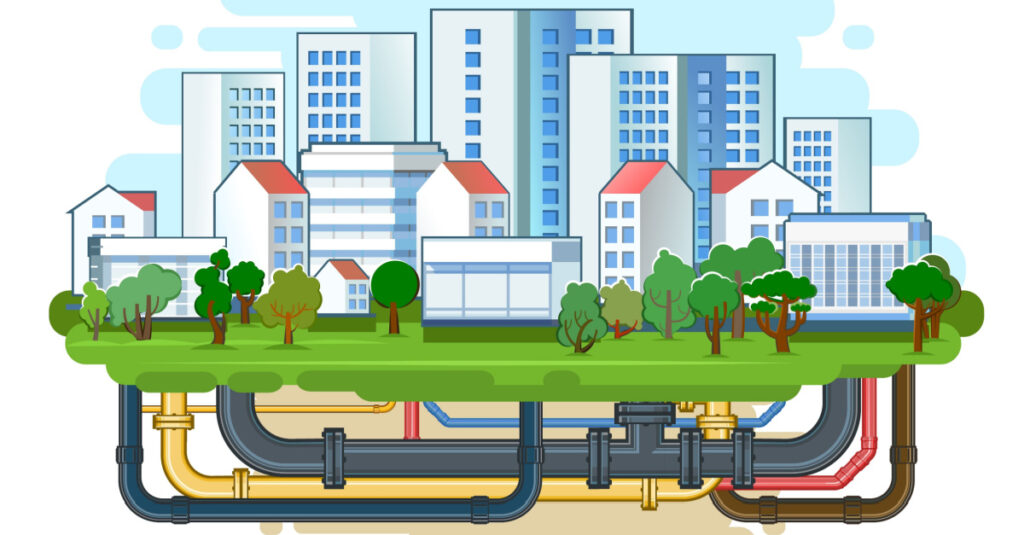“From the Field” is a series of interviews in which water utility operators share their insights and experiences on varied topics.
In this article, professionals at several utilities share their experience and thoughts about DMAs and the monitoring devices they use in them, current strategies and plans for the future.
Insights and experiences shared by:
- Cristian Jiménez, Operations Manager, Aguas Antofagasta, Chile
- Darren Cash, Customer Hub Manager, Sydney Water, Australia
- Francisco Iturriaga, Department Head, Operational Intelligence, Esval & Aquas del Valle, Valparaíso and Coquimbo, Chile
- Germán Ramos, Operations Manager, Sedapal, Peru
- Nick Goninan, Technical Officer Non-Revenue Water, Hunter Water, NSW, Australia
- Rhett Duncan, Executive Manager – Customer Delivery, Unitywater, Queensland, Australia
Answers have been edited for clarity and brevity.
Q: Please tell us about your DMA strategy: How did you sectorize your network, what monitoring devices do you use, and how has it working out for you?
Rhett, Unitywater: We operate about 180 DMAs with around 2,000 to 4,000 properties in each DMA. We use the DMA to identify water leaks and help us narrow down the potential for water leaks. In recent years, we rolled out small tests of smart meters, 300 here, 500 there. Now we’re rolling out a digital neighborhood, with 10,000 smart meters across three DMAs. Within those DMAs, we now have flow meters, pressure meter monitoring of what’s coming in, digital meters, acoustic leak detection, and water quality sensors, so we understand that what is going on within those DMAs in almost real time.
This initiative is not about proving the technology, as we know it works. Rather, it’s now about testing it en masse, and critically to help us build a business case to go forward to roll it out across the other 176 DMAs in the organization. As of now, we’ve got about 8,000 of those smart meters in the ground. With acoustic leak detection, we’ve already identified leaks that would have run to about 160 million liters of water had they had gone unnoticed in our trunk water main system. In addition to building the business case, the current trial is also about testing how Unitywater deals with the volume of data. How do we respond? How do we react when these alerts come in?
Francisco, Esval & Aquas del Valle: We have over 7,000 km of potable water, over 50 wastewater treatment plants, over 80 potable water plants, and more than 900,000 customers. We have a hilly topography and our water production catchment is far from the distribution areas, so we need many pressure reducing valves – over 1000 – to maintain the pressure within the allowed ranges.
Our work to sectorize the network began in 2014, and we now have around 460 DMAs. We wanted to illuminate our physical infrastructure, so we started with a massive installation of sensors and controllers – monitoring sensors, new pressure sensors, flow sensors, level sensors. Every year we install new sensors. Thanks to that monitoring and control work plan, in 2018 and 2019 we saw we had a lot of information, a lot of sensors generating big data, so we wanted to take better advantage of the information. That’s why we decided to test tools such as TaKaDu. Now we have more than 8,000 sensors that are generating events and alarms in TaKaDu, approximately 100 events monthly.
Learn more about Cenral Event Management – Contact us
Nick, Hunter Water: Back in 2015-16, we were surveying approximately 20% of the network and the decision was made to progress DMAs across the network to reduce internal water loss, repair point source leaks, and to ramp up our active leak detection. Our goal was to reduce real losses by 2.4 gigalitres per year by 2024. This would involve increasing our DMA coverage from 25% to 100% and to monitor on TaKaDu. We wanted to have a more targeted active leak detection program, increase the rollout of pressure managed zones, and continue our consumer water conservation strategy. In 2021, we reached 45% DMA coverage. It’s encouraging to us that each year from 2015, we’ve progressively been reducing our leakage rate and we hope to continue that.
In terms of DMA size, we aim to keep it to under 5,000 properties. At the moment, we have a number of large DMAs, and we’re still kind of learning what the sweet spot is.
Germán, Sedapal: Our first sectorization projects in Lima started in 1994. The first thing we did was divide the whole city into a grid of supply sectors based on two basic criteria: an average of 5,000 connections and serving an area of around 25 km2. Of course, in reality, this varies a lot. We tried where possible to divide the sectors along major avenues that would allow us to install two parallel pipes, so each sector would have its own independent pipe. The sectorization also included implementing a SCADA system. Today we have around 400 sectors. The entire central area city is sectorized and has automatic remote controls through a SCADA. This has allowed us to reduce non-revenue water, which in the 1990s was around 48%, to the current level of around 23%. We also have subsectors. Before the sectorization, the city was divided into large pressure zones, which meant if there was a major leak, we would have to cut off water to large areas. Now we can cut it off only at the subsector level.
Now we are installing data loggers, especially in the central areas of the city, to be able to manage pressure. Data loggers with GPS gives us a remote view of how the pressure varies across the various secondary city networks.
Darren, Sydney Water: We serve over five million customers. About 25% of our network is divided into small DMAs that are also pressure-managed. We’ve found that around 5,000 properties per DMA is pretty much the sweet-spot size. Each of those DMAs has a pressure-reducing valving, a flow meter, and one or two pressure gauges within the zone. We set them up from 2007 to 2010, and we’ve got some pretty good data on them now. Pressure management has resulted in a 4% to 5% reduction in the number of breaks and leakage within each zone. But one of the key things that the DMAs allow us to do is really to get a better handle on the leakage as it’s happening, and to target investigations rather than just doing blind active-leak detection, which is the traditional approach. And so, we’re able to see leaks as they happen pretty much straight away and initiate an investigation. We’ve had a lot of success with that approach, and that’s probably the biggest benefit of having small DMAs.
Cristian, Aguas Antofagasta: Antofagasta is in the foothills of the coastal mountain range. The distance between the coast and the most distant pond is only 3-4 km, but the difference in altitude can be over 200 m. Therefore, sectorization is something that has accompanied us since the development of the network, you could say the network is born “sectorized”.
I think that nowadays we should be shrinking these sectors, and in an ideal world we should also be moving towards sectors that are measured, because when we have a measured network, we have a clear idea of where we have to focus our efforts to meet objectives.
Before we started using TaKaDu in 2011, we had around one sensor for every 6-7 km of network. Since then, we have tripled the number of sensors (and as a result we needed fewer analysts, of course).
Q: What are your plans for upcoming changes to your DMAs and your metering strategies?
Rhett, Unitywater: The expectation is we will continue to roll out digital meters into the future. Probably, we’ll never be done with it, because I think the technology will always advance at a pace that our investment program can’t keep up with. We turn over our meters roughly every 15 years, so within the next 10 to 15 years, we would envisage all of our meters being smart meters. As to whether that will be integrated meters or mechanical meters with a clip-on, technology advances will direct that as we go.
We’ve also tested sewage monitoring and we plan to start installing some smart assets into our sewer network. We’re largely a coastal utility so we do suffer from tidal inundation, we have a lot of groundwater, a lot of sand. Inflow and infiltration are particular challenges for us. Last year, we treated about 10% more water than we sold, which says we have reasonably significant infiltration and inflow challenges across our network. Establishing real-time sewer monitoring will allow us to manage that and help us identify where we need to replace sewers. It will help inform our relining programs and, obviously, having real time data on what is actually going through the sewer network will help inform our tray waste program.
Nick, Hunter Water: The next stages will involve segmenting the existing networking to further DMAs and using virtual DMAs. At the moment, we have 120 flow meters in the network that contribute to DMAs. And we anticipate we’ll need an additional 200 to get us to 100% DMA coverage.
As we increase our DMA coverage of the network, we will use Takadu to direct our active leak detection, rather than just sweeping through the network. We’re also trialing residential smart meters to include billing into Takadu.
Germán, Sedapal: I’m convinced that sectorization alone is important, but it is more important if there were a tool that manages the big data that it creates. The information that you can have about the sectors, pressures, flows is so great that doing it manually is quite tedious, and tools like Takadu that analyze historical information, big data, and generate trend leakage are important. That is why we at Sedapal believe that we must implement a big data analysis system to be able to complement the advanced sectorization that we already have.
Darren, Sydney Water: If we were designing a system from scratch, we’d aim for full coverage of DMAs across our network. But given some of our massive gravity systems, and the complexity with doing that, it’s too complex. We are starting to roll out digital meters, so there is an opportunity to incorporate pressure sensors into some of them. We’d have at least one pressure sensor within each isolation block of around 20 to 30 properties, which would give us a real ability to pinpoint where something may have happened.
A note from the TaKaDu team
It’s commonly said you can’t manage what you don’t measure, and you can’t measure what you don’t monitor. In line with that, district metered areas (DMAs) are fundamental to effective management of any water network. The insights shared above highlight that every utility approaches sectorization slightly differently and that DMA development is an ongoing process. For more insights and recommendations on how to approach sectorization – including a formula for calculating the ideal DMA size, see our in-depth article on DMA strategies.
About the From the Field series
Hearing from peers in other water utilities is one of the best ways to get new ideas and gain more understanding about issues and trends. Each From the Field article provides a platform for water professionals to share their thoughts on a particular topic.
This is the 4th article in the series. Read the previous articles:
- What Happens when you start bridging silos?
- Top Priorities 2022-2023
- How Utilities are Coping with Covid.
If you have ideas for other topics you would like to hear a range of views about, please let us know. And remember to check back here soon for the next article in the series.




